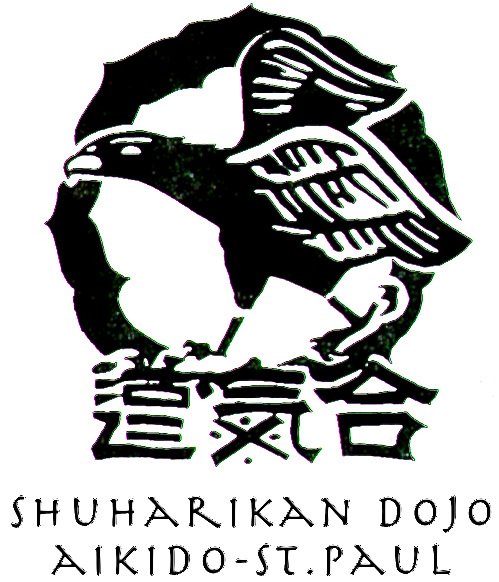What Is Aikido?
The word Aikido is usually translated as “The Way of Harmony.” It is difficult to define Aikido precisely because its meaning lies in the actual experience of the art. As one trains, the meaning becomes clear and deepens. The following description from The Shambala Guide to Aikido by John Stevens provides a basic glimpse of three dimensions of Aikido: “The principles of Aikido need to be experienced through actual practice. Training in Aikido consists of preliminary exercises to warm up the body and prepare the mind, paired exercises with a partner, and work with the bokken (wooden sword) and jo (wooden staff). The techniques include a variety of throws, locks, and pins (the martial art dimension); special exercises to foster physical and mental power (the psychological dimension); and tactics of nonviolence and harmonization (the spiritual dimension). In Aikido, a sincere practitioner continually strives to forge the body, discipline the mind, and polish the spirit.”
The Founder
An extraordinarily skilled Japanese martial artist named Morihei Ueshiba founded and developed a new martial art that eventually came to be known as Aikido. Ueshiba, referred to as O-Sensei (Great Teacher), was born in 1883 and died at the age of 86 in 1969. Right up until his death, he practiced and taught Aikido, and his final words included the statement, “Aikido is for the entire world.”In developing Aikido, O-Sensei incorporated various principles and techniques from several current and ancient martial arts, especially those of the sword arts of the samurai warriors. Many of the arts from which Aikido is derived were combat arts, intended for effectiveness in warfare. But O-Sensei’s vision was that the way of harmony, even with its combat elements, would be used to resolve conflict peacefully and without harm to even the instigator of the conflict. In this sense, O-Sensei conceived of Aikido as both a martial art and a budo, or way of conducting one’s life in accordance with the principles of integrity, sincerity, self-confidence, courage, respect, courtesy, humility and generosity. All Aikido practitioners are encouraged to integrate those qualities into their lives.
Noting again O-Sensei’s deathbed declaration that Aikido is for everybody, John Stevens
“Another distinctive feature of Aikido is that everyone trains together: men women, young and old, veteran and novice, big and little, heavy and light, flexible and stiff, aggressive and passive. By training with different partners, one learns to tailor the techniques to fit each individual situation. This shared experience enables one to build a solid foundation in the art of living as well—one learns how to deal with all kinds of people.”
After O-Sensei’s death, many of his students pledged to carry out his wish of making Aikido available to the entire world. One unique characteristic of Aikido, as O-Sensei saw it, is its organic nature, its capacity to change to fit the situation. Therefore, techniques ultimately are not rigidly fixed but rather manifest certain principles that make them effective. Recognizing this fact, several of O-Sensei’s senior students developed their own interpretations of Aikido, providing us with various styles of the art. Nevertheless, all Aikido is fundamentally linked to O-Sensei’s teachings.
Yoshinkan Aikido
By the end of World War II, O-Sensei had (temporarily) retired from Aikido, and one of his most senior students, Gozo Shioda, obtained his permission to open a new dojo. Shioda’s father had established his own dojo in 1925, calling it the Yoshinkan, “The place of cultivating the spirit.” In 1955, Gozo Shioda assumed that name for his dojo in honor of his father, and his style of Aikido became known as the Yoshinkan style. The Japanese philosophical principle that gave birth to the name Yoshinkan is found in the directive: “Quietly cultivate the spirit of a steady, unwavering mind.”
We see this principle clearly reflected in the Yoshinkan style and its training, physically and mentally. Balance and alignment are keys to the effective performance of Aikido. Strength and force are negated if one fails to maintain balance, and this insight is the essence of techniques. A small, even frail, person who is able to maintain unwavering physical and mental balance and yet upset the balance of a larger, stronger individual has a great advantage in a conflict.
As Yoshinkan Aikido developed, a unique teaching method emerged that emphasizes certain basic ways of moving in balance and alignment. By practicing these basic movements, the Aikido student eventually discovers the underlying principles that make actual techniques effective.


